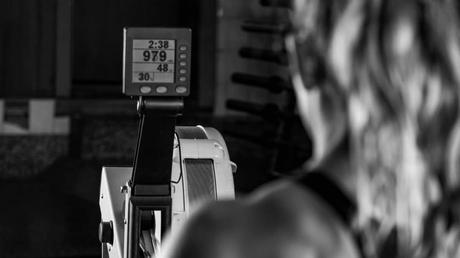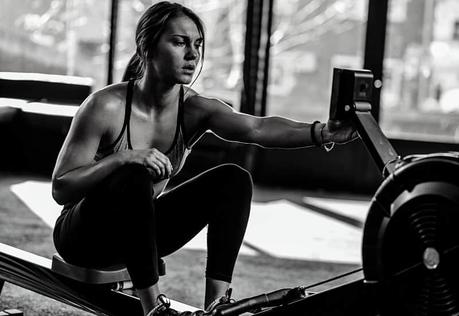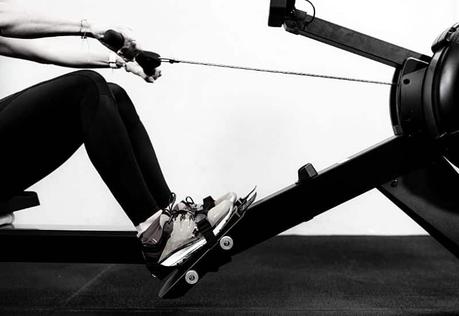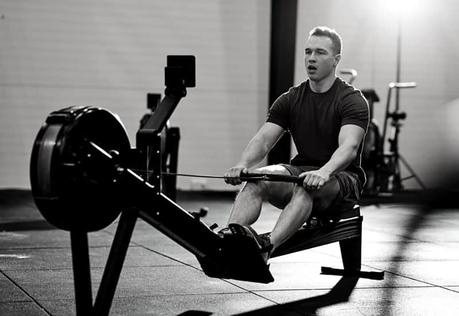The rowing machine is a killer form of cardio and a total body workout (well, almost). But that’s just two of the reasons to use the rower the next time you hit the gym.

- The Pros of Rowing Machines
- The Cons of Rowing Machines
- Rowing Machine Benefits – FAQs
- The Bottom Line
The rowing machine is one of the most popular cardio machines in the gym for a good reason: it delivers results in a way that few others can.
Not only is it low-impact, but it’s also a highly functional form of exercise that translates into easier performance of your activities of daily life. Add to that excellent fat-burning and full-body muscle engagement, and you can see why it’s a winner in my books.
And those are just the first few benefits…
In this post, I’ll list the ten advantages of the rowing machine (yes, there are that many!) and show you why it’s worth spending more time on the rowing machine (versus other gym cardio machines).
By the time you finish this post, you may even be convinced it’s worth getting a rowing machine for your own home—that’s how good these machines are!
Let’s dive right in.
The Pros of Rowing Machines
 Benefit 1: Stronger Legs
Benefit 1: Stronger Legs

You may think that rowing is all in the arms, but that’s just what it looks like.
The truth is that your legs end up doing the majority of the work—at least 65 to 75%, according to the American Fitness Professionals and Associates1.
Your quads have to propel you backward during the second stage of the rowing stroke (called the “Drive”), and that’s where most of the rowing power comes from. You also have to pull your body forward on the sliding seat, which leads to stronger calves, hamstrings, and glutes.
Put the entire range of movement together, and you’ve got a recipe for a much stronger lower body!
 Benefit 2: Stronger Core
Benefit 2: Stronger Core

I LOVE the core focus of the rowing machine!
Your core is pretty much working through the entire range of motion:
- When you lean forward, your core braces so you can begin pulling on the handle.
- As you push backward with your legs, your core has to hinge your torso backward.
- As your arms begin to pull the handle toward you, your core has to brace to keep your torso upright.
- As you finish the rowing motion with your legs at full extension, your core stops your torso from hinging farther backward and maintains a firm upright posture.
- As you begin pull forward with your legs to come to the end of your stroke, your core muscles bend your torso forward.
Your abs and lower back do most of the work, with minimal engagement from your obliques. However, you can really focus on squeezing those core muscles at the beginning and end of each stroke to maximize muscle engagement.
The result: a more powerful, resilient core!
 Benefit 3: Stronger Pull Muscles
Benefit 3: Stronger Pull Muscles

As you saw in my rowing machine vs elliptical machine article, the rowing machine focuses chiefly on the upper body “pull muscles” without engaging the “push muscles.”
What this means is that your chest and triceps don’t really do any work while rowing, but the focus is all on your upper back, shoulders, biceps, and forearms.
(For more on ALL the muscles worked on the rowing machine, read this.)

And that’s a good thing!
Your “pull muscles” often do the majority of the work in your life anyways—from picking up your kids to lifting heavy groceries to pulling your body upward when climbing to trying to keep a tight grip on the leash of a very active and energetic dog.
The time you spend rowing will strengthen your upper body pull muscles in a way that no other cardio machine can!
 Benefit 4: More Fat-Burning
Benefit 4: More Fat-Burning

The rowing machine is one of my top choices for the best cardio machines for losing weight for one simple reason: it burns A LOT of calories.
According to Harvard Medical School2, a 30-minute moderate rowing session will burn around 300 calories (for a 190-pound person). Push the pace to make it a “vigorous” session, and that calorie burn rises to 440 calories in that same half-hour.
Each pound of body fat contains roughly 3,500 calories. To put it simply, eight vigorous 30-minute rowing sessions will be enough to burn that pound of body fat.
But it’s not just about the calories…
With rowing, you’re working in an “aerobic state”, which means your body is producing energy with the use of oxygen. Your body pulls oxygen from your bloodstream and mixes it with stored fats in order to power up your muscles.
In fact, your body can only burn fat in significant quantities when working in an aerobic state.
Trainer’s Note: The opposite of aerobic is anaerobic, which means producing energy without air. In an anaerobic state—such as high-intensity sprint training or weightlifting—your body can only burn stored glycogen, which is derived from carbohydrates.
Over the course of your 30 to 60-minute rowing session, you’ll burn through a lot of the easily available carbs-based energy stored in your bloodstream, but your body will also activate stored fats to use as energy.
Over time, you’ll see weight loss—the REAL weight loss, AKA fat-burning—because of the aerobic exercise.
 Benefit 5: Amazing Cardiovascular Training
Benefit 5: Amazing Cardiovascular Training

Like all forms of aerobic exercise, rowing is great for your cardiovascular conditioning.
Your cardiovascular system is made up of a lot of important parts:
- Your lungs, which absorb oxygen from the air you breathe
- Your heart, which pumps that oxygenated blood throughout your body
- Your blood vessels, which have to dilate in order to allow for increased blood flow
Aerobic exercise targets these parts in critical ways.
First off, it increases your body’s ability to absorb oxygen, is measured as a percentage of the maximum volume of oxygen absorbed, or VO2 Max.
Your 100% VO2 Max is the maximum amount, but most people end up working at roughly 55 to 75% during their average aerobic training, or up to 90% during high-intensity intervals.
The more you push your lungs, the more efficient they are at absorbing oxygen, and thus your VO2 Max increases.

Second, it strengthens your heart muscles and increases that critical organ’s ability to pump blood at a consistent and increased rate throughout your body. You’ll find that over time, aerobic training can actually increase your Maximum Heart Rate (Max HR) while also lowering your resting heart rate.
Finally, aerobic exercise can clear out blockages from your blood vessels, increase their flexibility, strengthen the endothelial lining that keeps them functioning and resilient, and help them to dilate more effectively.
The result: a better-functioning cardiovascular system overall!
 Benefit 6: Low Injury Risk
Benefit 6: Low Injury Risk

It’s very uncommon to experience injuries while rowing—almost to the point of being nonexistent.
There are some repetitive motion injuries that are common (such as back pain, shoulder impingement, IT band friction in the knee, and wrist inflammation and tendon damage), but this is from the repeated rowing motion rather than any danger from the machine itself.
The chances of you causing an acute injury is unlikely; as long as you’re not overdoing it and rowing hundreds of miles a month, you shouldn’t have much to fear injury-wise.
 Benefit 7: Gentle on Your Joints
Benefit 7: Gentle on Your Joints

I know this may seem contradictory given all the repetitive motion injuries I mentioned above, but remember that those injuries are only likely with long-term, prolonged repetition. We’re talking high rowing volumes on par with professional athletes.
The average gym-goer and home trainee, however, has nothing to fear joint-wise. The rowing motion is very gentle on your joints with no impact, a natural range of motion, and excellent support from all the muscles surrounding the joints doing the work.
 Benefit 8: Great for Rehab
Benefit 8: Great for Rehab

Because there is no direct weight placed on your lower body joints (such as your ankles and knees), rowing is often used to help rehabilitate lower body injuries.
The range of motion can also help to facilitate better hip mobility, which is why it’s often allowed for patients following hip replacement surgery3.
Rowing can also help to increase strength and mobility in shoulders, elbows, and wrists following injury or surgery.
Really, the only joint not ideal for rehabbing using rowing is the lower back. There’s just too much strain on the lower back (with the continual bending forward and leaning back) to make it truly safe for anyone recovering from lower back injuries or surgeries—at least not until you’ve regained a measure of strength and stability in the spine.
 Benefit 9: Improve Your Posture
Benefit 9: Improve Your Posture

Rowing does amazing things for your posture!
Because you have to pay attention to your form during the rowing motion—driving using your legs rather than your upper body, leaning your torso back while pushing backward, combining your torso movement and arm movement into one smooth motion—it can help you to be more aware of the way you stand, sit, and even move.
No matter what type of rowing machine you use, the movement encourages significant improvement in posture.
Fun Fact: A study with 20 people found that with six weeks of training on a rowing machine significantly increased fat mass and total body fat percentage. Back strength and trunk flexion also improved big-time4.
 Benefit 10: Beginner-Friendly
Benefit 10: Beginner-Friendly

And this is probably my FAVORITE benefit of all.
For newbies at the gym or working out at home, it can often be hard to find a machine that’s easy to use right off the bat.
The treadmill and elliptical machine can be a bit awkward at first, the stair climber is HARD, and it takes your butt time to get accustomed to the way a stationary bike or spinning bike seat feels (not a favorite of mine).
But with the rowing machine, you can basically sit down and get rowing right away. There’s no real learning curve to it—once you’ve got the form down right, you can row your heart out safely and comfortably.
The Cons of Rowing Machines
While the rowing machine is easily one of the best cardio machines around, it’s not exactly perfect. There are a couple of drawbacks and cons you need to know about:
It can cause lower back injury.
This is especially true for those who are already experiencing lower back pain/stiffness/mobility problems, as well as those who over-exert themselves or train using the wrong form.
Learning the right form and posture can go a long way toward mitigating the risks, but anyone who is prone to back problems needs to be aware that the rowing machine may exacerbate existing injuries.

It’s not the most “fun.”
With other machines—such as the treadmill, elliptical, or stair climber—you’ve got options for switching up the workout, and the built-in screens make it easy to watch TV or read a book while working out. That’s not the case with rowing machines.
Most rowing machines are simple and designed for the single purpose of working out. The repeated forward and back movement can grow tedious after a while, and with no easy way to entertain yourself, it can get boring.
Rowing Machine Benefits – FAQs
Can you get in shape by just rowing?
You absolutely can!
However, there is a “but” you need to know about. When I say “get in shape by rowing”, I mean improve your aerobic conditioning and develop good cardiovascular endurance.
You can also build muscular endurance, but it will only be for the muscles used during the rowing motion—that is to say, many, but not all of them.
If you were to only row, with no other form of exercise, you’d develop muscular imbalances with all the strength in your “pull muscles” but very little in your “push muscles”.
Is it okay to use the rowing machine every day?
Rowing is likely to cause repetitive motion injuries if you’re not careful, perhaps more so than most other cardio machines.
It’s better not to use the rowing machine daily—instead, use it 2-3 times a week, adding in other cardio machines and workouts—in order to not only keep your joints safe, but also switch up the muscles worked and train your body through different ranges of motion.
Variety isn’t just what stops the workouts from getting boring; it also helps to improve your fitness overall across multiple activities and movements.
The Bottom Line
As you can see, there are A LOT of benefits to using the rowing machine, with only a couple of (fairly minor) downsides.
If you’re looking for a good addition to your home workout setup or a cardio machine where you can spend most of your gym time training, the rowing machine is definitely a great choice!
More Stuff Like This
The Best Cardio Workouts to Do at the Gym (Plus Benefits, Machines, and Sample Workouts). Ready to take your cardio game to the next level? Here’s a look at the best cardio workouts to do at the gym, benefits, and the best cardio machines to use.
